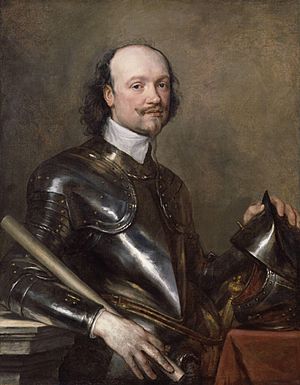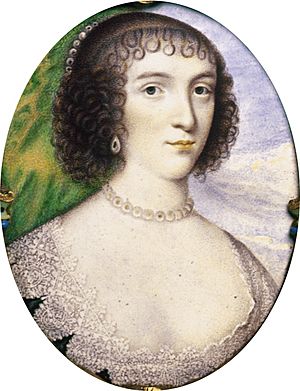Venetia Stanley facts for kids



Venetia Anastasia, Lady Digby (née Stanley; born December 1600 – died 1 May 1633) was a famous beauty during the Stuart period in England. She was married to Sir Kenelm Digby, who was a well-known courtier and scientist. Venetia was the granddaughter of Thomas Percy, 7th Earl of Northumberland and the great-granddaughter of Edward Stanley, 3rd Earl of Derby.
Contents
Early Life and Family
Venetia Stanley was the third daughter of Sir Edward Stanley. Her father was a baronet, which is a special title of honor. Her mother, Lucy Percy, was the daughter of the Earl of Northumberland. Sadly, Lucy Stanley died just a few months after Venetia was born.
The name "Venetia" likely comes from the Latin word for "Gwyneth". Venetia Stanley helped make this name popular in England.
A Famous Love Story
Venetia was known for her beauty. When she was a teenager, she was presented at the court of King James I. Around this time, she met Kenelm Digby again. They had known each other as children and quickly fell in love. They exchanged special gifts: Venetia gave Kenelm a lock of her hair, and he gave her a diamond ring.
Kenelm's mother did not approve of their relationship. She sent him on a "Grand Tour" of Europe. This was a long trip that young noblemen often took to learn about other countries. While in France, Kenelm let people believe he had died to avoid a difficult situation. In England, Kenelm's mother hid his letters to Venetia. This made Venetia believe he was truly gone, and she was very sad.
During this time, some people spread rumors about Venetia. An old writer named John Aubrey later wrote that she had relationships with other men. However, historical records do not support these claims. For example, one man he mentioned had died before Kenelm was thought to be dead. Also, another man's will did not mention any children with Venetia, even though Aubrey claimed they had some.
Venetia also had a close friendship with Edward Sackville. He even fought a famous duel over her. Despite this, Edward remained friends with both Venetia and Kenelm after they married.
Marriage and Family Life
When Kenelm returned to England, it took time for him and Venetia to fix things. There were misunderstandings and rumors. But in 1624, Venetia showed her deep feelings for Kenelm. She sold her jewelry to help him with his living expenses while he was on a diplomatic trip to France.
Kenelm and Venetia likely married in January 1625. They kept their marriage a secret from Kenelm's mother. In October 1625, while Kenelm was away, Venetia gave birth to their first son, Kenelm, in secret. She later had three more sons: John, George, and Everard. Sadly, Everard died when he was a baby. Venetia also had a miscarriage of twins.
Venetia was a very religious person. Her husband said she lived a "blameless" life. She went to Mass every day and prayed for many hours. She also joined a religious group and helped poor people in London. She even used money she won from card games to fund her charity work.
Later Life and Legacy
In April 1633, Venetia Digby died suddenly in her sleep. Kenelm was heartbroken. He allowed doctors to perform an autopsy, which was not common at the time. He said she had suffered from headaches for eight years. Doctors reported finding a problem with her brain.
Venetia's death was a huge tragedy for Kenelm. It changed his life forever. Even though he had not always been faithful, he never remarried after her death. He became a more serious scientist and a Catholic writer. He had plaster casts made of her head, hands, and feet. He also asked his friend, the artist Anthony van Dyck, to paint Venetia on her deathbed.
Venetia was buried in London in a beautiful marble tomb. Kenelm later sent their children to live with their grandmother. He moved to Gresham College and spent time writing letters praising his wife. These letters, along with poems by other writers, were collected into a book called In Praise of Venetia.
Kenelm Digby was buried in the same tomb as Venetia when he died in 1665. He wanted his "dust lie by hers who was my greatest worldly blessing." Just a year later, the church and tomb were destroyed in the Great Fire of London. An old writer, John Aubrey, later saw a part of Venetia's tomb in a shop window, but it was later melted down.
Sir Kenelm wrote a "Private Memoir" about their love story. It used made-up names for the characters, but it is a main source of information about Venetia. The book describes their childhood romance, the challenges they faced, and their secret marriage.
In Fiction
Venetia Digby and her husband are characters in the 2014 novel Viper Wine by Hermione Eyre.
Portraits
- Isaac (or Peter?) Oliver, possibly Lady Venetia Stanley, later Digby, around 1615, Victoria and Albert Museum, London
- After Antony van Dyck, double portrait miniature, 1632, Sherborne Old Castle, Dorset
- After Antony van Dyck, double portrait miniature, with Kenelm Digby, Sherborne Old Castle, Dorset
- After Antony van Dyck, family portrait, with children, 1633
- Antony van Dyck, Venetia Stanley on her deathbed, 1633, Dulwich Picture Gallery, London
- Antony van Dyck, portrait, two versions, in Palazzo Reale, Milan; and in the Royal Collection, Windsor
- Henri Toutin, miniature, 1637, Walters Art Museum, Baltimore
- Isaac (or Peter?) Oliver, miniature, no date given


